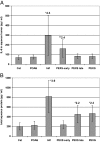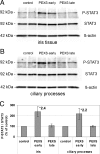Proinflammatory cytokines are involved in the initiation of the abnormal matrix process in pseudoexfoliation syndrome/glaucoma
- PMID: 20395431
- PMCID: PMC2877848
- DOI: 10.2353/ajpath.2010.090914
Proinflammatory cytokines are involved in the initiation of the abnormal matrix process in pseudoexfoliation syndrome/glaucoma
Abstract
Pseudoexfoliation (PEX) syndrome, which is an age-related, generalized elastotic matrix process, currently represents the most common identifiable risk factor for open-angle glaucoma. Dysregulated expression of proinflammatory cytokines has been implicated in the initiation of various fibrotic disorders and in the pathophysiology of glaucoma. Here we investigated the presence, expression, regulation, and functional significance of proinflammatory cytokines in eyes with early and late stages of PEX syndrome/glaucoma in comparison with normal and glaucomatous control eyes using multiplex bead analysis, immunoassays, real-time PCR, Western blotting, immunohistochemistry, and cell culture models. Early stages of PEX syndrome were characterized by approximately threefold (P < 0.005) elevated interleukin (IL)-6 and IL-8 levels in the aqueous humor and a concomitant approximately twofold (P < 0.001) increase in mRNA expression levels in anterior segment tissues as compared with controls. In contrast, late stages of PEX syndrome/glaucoma did not differ significantly from controls. IL-6, IL-6 receptor, and phospho-signal transducer and activator of transcription 3 could be mainly localized to walls of iris vessels and to the nonpigmented epithelium of ciliary processes. IL-6 and IL-8 were significantly up-regulated by ciliary epithelial cells in response to hypoxia or oxidative stress in vitro, whereas IL-6, but not IL-8, induced the expression of transforming growth factor-beta1 and elastic fiber proteins. These findings support a role for a stress-induced, spatially, and temporally restricted subclinical inflammation in the onset of the fibrotic matrix process characteristic of PEX syndrome/glaucoma.
Figures








References
-
- Schlötzer-Schrehardt U, Naumann GOH. Ocular and systemic pseudoexfoliation syndrome. Am J Ophthalmol. 2006;141:921–937. - PubMed
-
- Ritch R, Schlötzer-Schrehardt U. Exfoliation syndrome. Surv Ophthalmol. 2001;45:265–315. - PubMed
-
- Ovodenko B, Rostagno A, Neubert TA, Shetty V, Thomas S, Yang A, Liebmann J, Ghiso J, Ritch R. Proteomic analysis of exfoliation deposits. Invest Ophthalmol Vis Sci. 2007;48:1447–1457. - PubMed
-
- Zenkel M, Kruse FE, Jünemann AG, Naumann GOH, Schlötzer-Schrehardt U. Deficiency of the extracellular chaperone clusterin in eyes with pseudoexfoliation syndrome may be implicated in the aggregation and deposition of pseudoexfoliative material. Invest Ophthalmol Vis Sci. 2006;47:1982–1990. - PubMed
Publication types
MeSH terms
Substances
LinkOut - more resources
Full Text Sources
Other Literature Sources

